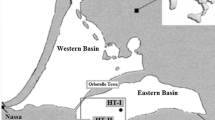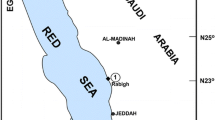Abstract
Clearwater Mesa is a pristine area located SE of Croft Bay in James Ross Island, at the northeast of the Antarctic Peninsula. The closest anthropic construction is the summer Mendel station located 25 km to the NE. Clearwater is a remote basalt volcanic mesa, (64° 01′ S, 57° 42′ W) located at ~ 250 m a.s.l., with around 50 small shallow lakes, a well-developed lichens flora and scarce fauna. The mesa offers a good opportunity to use lichens, like Usnea antarctica, as a biomonitor species. The aim of this study was to determine the baseline levels of trace elements in Usnea antarctica and their relationships with geographical parameters and climatological aspects, to use them as reference levels in futures studies. Usnea antarctica was collected in 23 sites in two transects: perpendicular and parallel to the shore. We found high contents of the elements associated with long-distance transport like Sm, La, Sc, Fe, Co, Hg, and Ca. The elements linked to the marine biogenic cycle as Sr, Rb, Cs, K, Na, Sb, As, Se, and Br were less significant. The distance to the sea was the factor that related the element contents. Hg, Se, As, and Br content in Usnea antarctica increased from the inland towards the sea coast.



Similar content being viewed by others
References
Arimoto, R., Duce, R. A., Ray, B. J., & Unni, C. K. (1985). Atmospheric trace elements at Eniwetok atoll: 2. Transports the ocean by wet and dry deposition. Journal of Geophysical Research, 90, 2391–2408. https://doi.org/10.1029/JD090iD01p02391.
Aschenbrenner, I., Cernava, T., Berg, G., & Grube, M. (2016). Understanding microbial multi-species symbioses. Frontiers in Microbiology, 7, 180. https://doi.org/10.3389/fmicb.2016.00180.
Bargagli, R. (2008). Environmental contamination in Antarctic ecosystems. Science of the Total Environment, 400, 212–226. https://doi.org/10.1016/j.scitotenv.2008.06.062.
Bargagli, R. (2016a). Moss and lichen biomonitoring of atmospheric mercury: A review. Science of the Total Environment, 572, 216–231. https://doi.org/10.1016/j.scitotenv.2016.07.202.
Bargagli, R. (2016b). Atmospheric chemistry of mercury in Antarctica and the role of cryptogams to assess deposition patterns in coastal ice-free areas. Chemosphere, 163, 202–208. https://doi.org/10.1016/j.chemosphere.2016.08.007.
Bargagli, R., Battisti, E., Focardi, S., & Formichi, P. (1993). Preliminary data on environmental distribution of mercury in northern Victoria Land, Antarctica. Antarctic Science, 5(1), 3–8. https://doi.org/10.1017/S0954102093000021.
Bohuslavová, O., Šmilauer, P., & Elster, J. (2012). Usnea lichen community biomass estimation on volcanic mesas, James Ross Island, Antarctica. Polar Biology, 35(10), 1563–1572. https://doi.org/10.1007/s00300-012-1197-0.
Bokhorst, S., Convey, P., Huiskes, A., & Aerts, R. (2016). Usnea antarctica, an important Antarctic lichen, is vulnerable to aspects of regional environmental change. Polar Biology, 39(3), 511–521. https://doi.org/10.1007/s00300-015-1803-z.
Brooks, S., Arimoto, R., Lindberg, S., & Southworth, G. (2008a). Antarctic polar plateau snow surface conversion of deposited oxidized mercury to gaseous elemental mercury with fractional long-term burial. Atmospheric Environment, 42, 2877–2884. https://doi.org/10.1016/j.atmosenv.2007.05.029.
Brooks, S., Lindberg, S., Southworth, G., & Arimoto, R. (2008b). Springtime atmospheric mercury speciation in the McMurdo, Antarctica coastal region. Atmospheric Environment, 42, 2885–2893. https://doi.org/10.1016/j.atmosenv.2007.06.038.
Bubach, D., Catán, S. P., Di Fonzo, C., Dopchiz, L., Arribére, M., & Ansaldo, M. (2016). Elemental composition of Usnea sp. lichen from Potter Peninsula, 25 de Mayo (King George) Island, Antarctica. Environmental Pollution, 210, 238–245. https://doi.org/10.1016/j.envpol.2015.11.045.
Cossa, D., Heimbürger, L.-E., Lannuzel, D., Rintoul, S. R., Butler, E. C. V., Bowie, A. A., Averty, B., Watson, R. J., & Remenyi, T. (2011). Mercury in the Southern Ocean. Geochimica et Cosmochimica Acta, 75, 4037–4052. https://doi.org/10.1016/j.gca.2011.05.001.
Culicov, O. A., Yurukova, L., Duliu, O. G., & Zinicovscaia, I. (2017). Elemental content of mosses and lichens from Livingston Island (Antarctica) as determined by instrumental neutron activation analysis (INAA). Environmental Science and Pollution Research, (6), 24, 5717–5732. https://doi.org/10.1007/s11356-016-8279-4.
Duce, R. A., Ray, B. J., Hoffman, G. L., & Walsh, P. R. (1976). Trace metal concentration as a function of particle size in marine aerosols from Bermuda. Geophysical Research Letters, 3(6), 339–342. https://doi.org/10.1029/GL003i006p00339.
Garty, J. (2001). Biomonitoring atmospheric heavy metals with lichens: Theory and application, critical. Reviews in Plant Sciences, 20(4), 309–371. https://doi.org/10.1080/20013591099254.
Gworek, B., Bemowska-Kałabun, O., Kijeńska, M., & Wrzosek-Jakubowska, J. (2016). Mercury in marine and oceanic waters, a review. Water, Air & Soil Pollution, 227, 371. https://doi.org/10.1007/s11270-016-3060-3.
Hjort, C., Ingólfsson, Ó., Möller, P., & Lirio, J. M. (1997). Holocene glacial history and sea-level changes on James Ross Island, Antarctic Peninsula. Journal of Quaternary Science, 12(4), 259–273. https://doi.org/10.1002/(SICI)1099-1417(199707/08)12:4%3C259::AID-JQS307%3E3.0.CO;2-6.
Kappen, L., & Redón, J. (1987). Photosynthesis and water relations of three maritime Antarctic lichen species. Flora, 179, 215–229. https://doi.org/10.1016/S0367-2530(17)30240-2.
Kim, I., Kim, G., & Choy, E. J. (2015). The significant inputs of trace elements and rare earth elements from melting glaciers in Antarctic coastal waters. Polar Research, 34, 24289. https://doi.org/10.3402/polar.v34.24289.
Lecomte, K. L., Vignoni, P. A., Echegoyen, C. V., Santolaya, P., Kopalova, K., Kohler, T. J., Roman, M., Coria, S. H., & Lirio, J. M. (2020). Dissolved major and trace geochemical dynamics in Antarctic lacustrine systems. Chemosphere, 240(2020). https://doi.org/10.1016/j.chemosphere.2019.124938.
Lim, H. S., Han, M. J., Seo, D. C., Kim, J. H., Lee, J. I., Park, H., Hur, J. S., Cheong, Y. H., Heo, J. S., Yoon, H. I., & Cho, J. S. (2009). Heavy metal concentrations in the fruticose lichen Usnea aurantiacoatra from King George Island, South Shetland Islands, West Antarctica. Journal of the Korean Society for Applied Biological Chemistry, 52(5), 503–508. https://doi.org/10.3839/jksabc.2009.086.
Lirio, J. M., Coria, S. H., Lopes, N., Vignoni, P. A., Kohler, T. J., Kopalová, K., Chaparro, M. A., Lecomte, K. L., Nývlt, D., & Mac Cormack, W. P. (2015). Lagos y lagunas de la meseta Clearwater, Isla James Ross, Península Antártica. Punta Arenas: VIII Congreso Latinoamericano de Ciencia Antártica, CLCA.
Maenhaut, W., & Zoller William, H. (1979). Concentration and size distribution of particulate trace elements in the south polar atmosphere. Journal of Geophysical Research, 84(C5), 2421–2431. https://doi.org/10.1029/JC084iC05p02421.
Muggia, L., & Grube, M. (2018). Fungal diversity in lichens: From extremotolerance to interactions with algae. Life, 8(2), 15. https://doi.org/10.3390/life8020015.
Nieboer, E., & Richardson, D. H. S. (1978). Lichens and ‘heavy’ metals. International Lichenological Newsletter, 1, 1–3.
Øvstedal, D. O., & Lewis Smith, R. (2001). Lichens of Antarctica and South Georgia: A guide to their identification and ecology. Cambridge: Cambridge University Press.
Perez Catán, S., Bubach, D., Messuti, M. I., María Angélica Arribére, M. A., & Ribeiro Guevara, S. (2019). Mercury in a geothermal and volcanic area in Patagonia, southern South America. Atmospheric Pollution Research, 11, 566–573. https://doi.org/10.1016/j.apr.2019.12.005.
Purvis, O. W., Seaward, M. R. D., & Loppi, S. (2007). Lichens in a changing pollution environment: An introduction. Environmental Pollution, 146, 291–292. https://doi.org/10.1016/j.envpol.2006.03.048.
Rindita, L., Sudirman, I., & Koesmaryono, Y. (2015). Air quality bioindicator using the population of epiphytic macrolichens in Bogor City, West Java. Journal of Biosciences, 22(2), 53–59. https://doi.org/10.4308/hjb.22.2.53.
Rivera, M. S., Catan, S. P., Di Fonzo, C., Dopchiz, L., Arribere, M. A., Ansaldo, M., Messuti, M. I., & Bubach, D. F. (2018). Lichen as biomonitor of atmospheric elemental composition from Potter Peninsula, 25 de Mayo (King George) Island, Antarctica. Annals of Marine Science, 2(1), 009–015. https://doi.org/10.17352/ams.000009.
Roman, M., Nedbalová, L., Kohler, T. J., Lirio, J. M., Coria, S. H., Kopáček, J., Vignoni, P. A., Kopalová, K., Lecomte, K. L., Elster, J., & Nývlt, D. (2019). Lacustrine systems of Clearwater Mesa (James Ross Island, north-eastern Antarctic Peninsula): Geomorphological setting and limnological characterization. Antarctic Science, 31(4), 169–188. https://doi.org/10.1017/S0954102019000178.
Smellie, J. L., Johnson, J. S., McIntosh, W. C., Esser, R., Gudmundsson, M. T., Hambrey, M. J., & Van Wyk De Vries, B. (2008). Six million years of glacial history recorded in volcanic lithofacies of the James Ross island volcanic group, Antarctic peninsula. Palaeogeography, Palaeoclimatology, Palaeoecology, 260, 122–148. https://doi.org/10.1016/j.palaeo.2007.08.011.
Smellie, J. L., Johnson, J. S., & Nelson, A. E. (2013). Geological Map of James Ross Island 1. James Ross Island Volcanic Group (1:125 000 scale). BAS GEOMAP 2 Series, Sheet 5, 10.1029/2006GC 001450.20.
Sojo, F., Romeike, J., & Ott, S. (2003). Himantormia lugubris (Hue) M. Lamb - vegetative and reproductive habit: Adaptations of an Antarctic endemic. Flora, 198, 118–126. https://doi.org/10.1078/0367-2530-00083.
Spribille, T., Tuovinen, V., Resl, P., Vanderpool, D., Wolinski, H., Aime, M. C., Schneider, K., Stabentheiner, E., Toome-Heller, M., Thor, G., Mayhofer, H., Johannesson, H., & McCulcheon, J. P. (2016). Basidiomycete yeasts in the cortex of ascomycete macrolichens. Science, 353, 488–492. https://doi.org/10.1126/science.aaf8287.
Van Lipzig, N. P. M., Turner, J., Colwell, S. R., & Van Den Broeke, M. R. (2004). The near-surface wind field over the Antarctic Continent. International Journal of Climatology, 24(15), 1973–1982. https://doi.org/10.1002/joc.1090.
Wen, H., & Carignan, J. (2007). Reviews on atmospheric selenium: Emissions, speciation and fate. Atmospheric Environment, 41, 7151–7165. https://doi.org/10.1016/j.atmosenv.2007.07.035.
Wen, H., & Carignan, J. (2009). Ocean to continent transfer of atmospheric Se as revealed by epiphytic lichens. Environmental Pollution, 157, 2790–2797. https://doi.org/10.1016/j.envpol.2009.04.021.
Xu, G., & Gao, Y. (2014). Atmospheric trace elements in aerosols observed over the Southern Ocean and coastal East Antarctica. Polar Research, 33(1), 23973. https://doi.org/10.3402/polar.v33.23973.
Zvěřina, O., Coufalík, P., Barták, M., Petrov, M., & Komárek, J. (2018). The contents and distributions of cadmium, mercury, and lead in Usnea antarctica lichens from Solorina Valley, James Ross Island (Antarctica). Environmental Monitoring Assessment, 190, 13. https://doi.org/10.1007/s10661-017-6397-1.
Zvěřina, O., Láska, K., Červenka, R., Kuta, J., Coufalík, P., & Komárek, J. (2014). Analysis of mercury and other heavy metals accumulated in lichen Usnea antarctica from James Ross Island, Antarctica. Environmental Monitoring Assessment, 186(12), 8089–9100. https://doi.org/10.1007/s10661-014-4068-z.
Acknowledgments
We thank the Dirección Nacional del Antártico, Instituto Antártico Argentino, PROANTAR (Programa Antártico Brasileiro), for their assistance on field trips, and also, the authors would like to recognize the RA-6 reactor staff, Centro Atómico Bariloche, CNEA, Argentina, for the irradiation of the samples. The authors would also like to thank Silvia H. Coria and Matej Roman for their great help in the field, to the two anonymous reviewers for constructive comments on the manuscript, and also to Matej Roman for the photomosaic used in Fig. 1a.
Funding
M.J. Kitaura and M.C. Scur are grateful to Coordenação de Aperfeiçoamento de Pessoal de Nível Superior – Brazil (CAPES) – Finance Code 001, which financed part of this study and scholarships, and to the Evolution and Dispersal of Antarctic Bipolar Species of Mosses and Lichens project (MCTI/CNPq).
Author information
Authors and Affiliations
Corresponding author
Ethics declarations
Statement on the welfare of animals
This article does not contain any studies with human participants or animals performed by any of the authors.
Additional information
Publisher’s note
Springer Nature remains neutral with regard to jurisdictional claims in published maps and institutional affiliations.
Electronic supplementary material
ESM 1
(DOCX 91 kb)
Rights and permissions
About this article
Cite this article
Catán, S.P., Bubach, D., Arribere, M. et al. Trace elements baseline levels in Usnea antarctica from Clearwater Mesa, James Ross Island, Antarctica. Environ Monit Assess 192, 246 (2020). https://doi.org/10.1007/s10661-020-8212-7
Received:
Accepted:
Published:
DOI: https://doi.org/10.1007/s10661-020-8212-7




